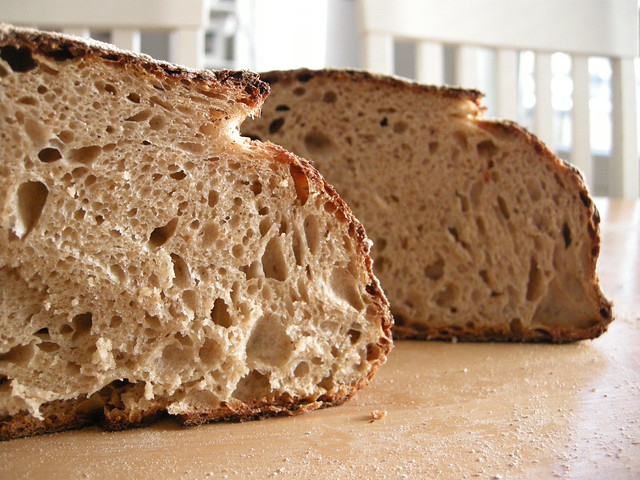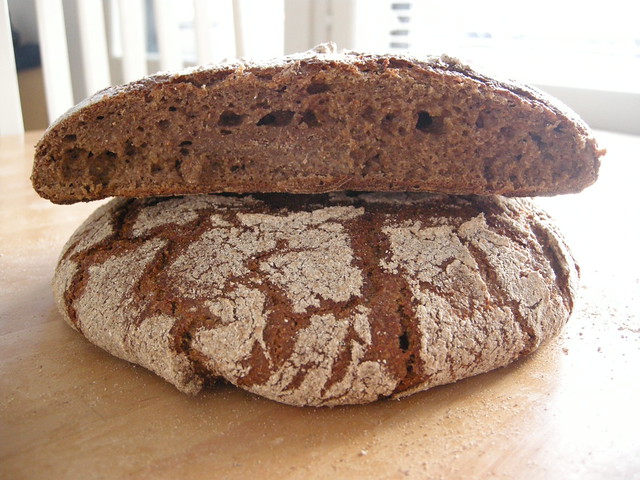For about two months, I had had my sourdough starter sitting on the kitchen counter covered with a kitchen towel. Last week, when I finally found time to look at it again, it looked like a dry cracker cookie.
I had no idea if I could still restore the starter or not, but I decided to give it a try.
I added some water to dilute the dried starter. When most of the starter had turned into a milk-like fluid, I removed the remaining pieces of dry dough and added just enough flour to get it back to the normal consistency of my starter (at 100% hydration, 50/50 full grain and all purpose flour). I then left the starter on the kitchen counter and waited. The next morning, the starter was full of life!
Just look at this before and after photo:

After a couple of days of daily feeding cycles, I finally had the time to try to bake something with the starter.
--
About two weeks ago, I visited Viipurilainen kotileipomo, a family run bakery in Lahti, about 100 kilometers from Vantaa where I live to meet with the bakers and see how they work on their full-grain rye bread (among other things). The four baking brothers I met that night where some of the friendliest people I have ever met, and their rye "limppu" is delicious! So, inspired by seeing them at work, although I didn't ask for their recipe, I decided to try my luck with creating my own version of this Finnish tradition called "ruislimppu."

At about the same time as I started reviving my old wheat starter, I created a 100% rye starter by mixing a handful of dark rye flour and some water. I didn't write down the exact measurements but it resulted in a rather wet and sticky dough to start with. I fed the starter daily, slowly increasing the mass of the dough, until it felt really sour and light. Ready for use. That was the night before the bake. Last week's Saturday.
On that night, I made the rye "limppu" dough by mixing the starter with about 1.5 kilograms of rye flour and 1 kilograms of water. As I don't know the amount of flour and water in the starter, I can't give exact figures. I will try to be more exact the next time I make this bread... I didn't knead the dough at this point, just mixed the ingredients to a consistent mass.
On Sunday morning, I mixed in the salt and did a very brief kneading for the dough. The dough was quite wet and it was practically impossible to knead, so I didn't spend much time on it. At the same time, I also prepared a batch of my favorite dough for two loaves of Basic Country Bread from Tartine Bread.
I was baking for most of the day, and here are the results. I'm pretty happy with them: even the rye limppu tastes right. The rye loaves could be a bit lighter (it's definitely denser and flatter than the one from Viipurilainen kotileipomo), but that's not necessarily a requirement: most of the time they look just like this when you buy them from Finnish grocery stores: dense and dark, but full of flavor (especially with a thick layer of real, creamy butter on top!).
Basic Country Bread:


Rye Limppu:



- jarkkolaine's Blog
- Log in or register to post comments
Hi Jarkko,
Glad your starter is back with the living :) I don't think I could ever just leave mine to dry out ... too much time and effort invested in it ... bakers pride :)
I find the finnish rye breads fascinating ... the Kotilimppu ruisleipä bread on their website looks awesome :) Butter on top is the way for sure! Was doing some reading about whole-grain rye breads last night and how they were eaten hand-in-hand with lots of dairy in the northern European countries. They compliment each other nutritionally.
Your Tartine crumb looks delightful ... what flour are you using for that? ... and the rye looks pretty amazing too ... is it about 2kg? If so that's pretty impressive. I find I really have to crank up the heat in the oven for those kinds of breads .... Do you know if that's how they make them at Viipurilainen kotileipomo?
Thanks so much for posting your rye adventures ... looking forward to more finnish ryes perhaps :)
Cheers,
Phil
I know... I felt so ashamed of myself when I realized what I had done to my starter. But then I thought that in the old times, that's exactly how my Finnish ancestors used to store their starters (they left the remains of the rye dough to dry on the sides of the wooden bowls, and then when it was time to bake again, spent a day or two soaking them back to life), and luckily enough, it seems as if my starter came just stronger with this "experiment" ;)
I didn't know about the nutritional part, but dairy products sure taste good with a slice of dark rye bread.
About the flour... I'm using a little whole grain wheat and mostly what we call "hiivaleipäjauho", I guess that would be bread flour... I'm stills somewhat confused with how the flours in different countries relate to each other :)
And the rye loafs are about 1 kg. The ones at Viipurilainen are bigger than mine. I'm not sure about the temperature they use, they may have told it but there was so much information to digest that it escaped my mind... But there will definitely be more rye adventures ahead for me. This summer, I'm planning to visit the mill where Viipurilainen gets their stone ground rye flour and try to make some bread with it...
Cheers,
Jarkko
So glad that your dry starter came back to life- read somewhere recently- forget where- that it takes about five days to revive a dried starter, but it sounds like yours did better than that. :)
Finnish rye breads are so interesting, looking forward to seeing more of your baking and hearing about your mill expedition. Thanks for the post!
Thanks, FlourChild! :)
Looking forward to visiting the mill and trying some stone ground flour... So far, I have always bought my flour from the grocery store and it will be interesting to buy fresh flour directly from the producer.
you saved your starter from a dry near ndeath experience. Your breads are very nice - I love the cruwst and crumb. They must taste great.
Thanks, dabrownman! :)
Jarkko,
Thanks for this post and the photo of your starter. I have only been baking with sourdough for a little over a year and in that time I have found that sd is very hardy stuff despite how we humans treat it.
The fact that baking with it has survived throughout the ages in many different cultures attests to it's adaptability. Makes sense since it is bacteria and yeast they certainly know how to survive in 'adverse' situations a lot better than we humans do. They are better adapted to it. Makes one wonder just 'who' truly is more evolved.....
One poster here encouraged rougher treatment of starters in order to keep them strong. I think she has something there and your recounting of your experience certainly backs that up as well as your description of how starters were kept going long ago before refrigeration and before people knew they were delicate things that needed pampering :-)
Again, thanks for sharing and for the look into that wonderful bakery and the delicious looking rye loaf.
Take Care,
Janet
Thanks Janet,
That's a good point. And after this experience, I am even more prone to believe it :)
Cheers,
Jarkko
Hi Jarkko,
The photos of your Tartine bread are breathtaking, and I love the crackled Finnish rye bread.
It's good to see how your starter really bounced back!
:^) breadsong
Thanks, breadsong! I'm happy to hear you like them :)
each time you bake is that the starter is a little unpredictable. You said it was more vigorous and that might explain the rye fed starter and bread, although beautifully crazed appears to be edging toward over-proofed. The light crust color, gummy crumb spot and the large irregular bubbles tell me it should have been baked sooner. I would try shortening the proof next time and/or adding the salt sooner to control the fermenting. I like to add salt about one hour after mixing the dough. :)
Hi Mini Oven,
And thanks for the tips! Sorry it took so long to get back to you. I was traveling for the past ten days (plus a couple of days of getting back to normal routines) with limited internet connectivity...
My normal starter is fed with just wheat (50/50 between full grain and white flour), but I would guess you are right about the over-proofing. Today, I baked a batch of the same bread but delayed the fermentation by keeping the shaped breads in the fridge overnight, and the results were better, in my opinion. I'll keep experimenting :)
Cheers!